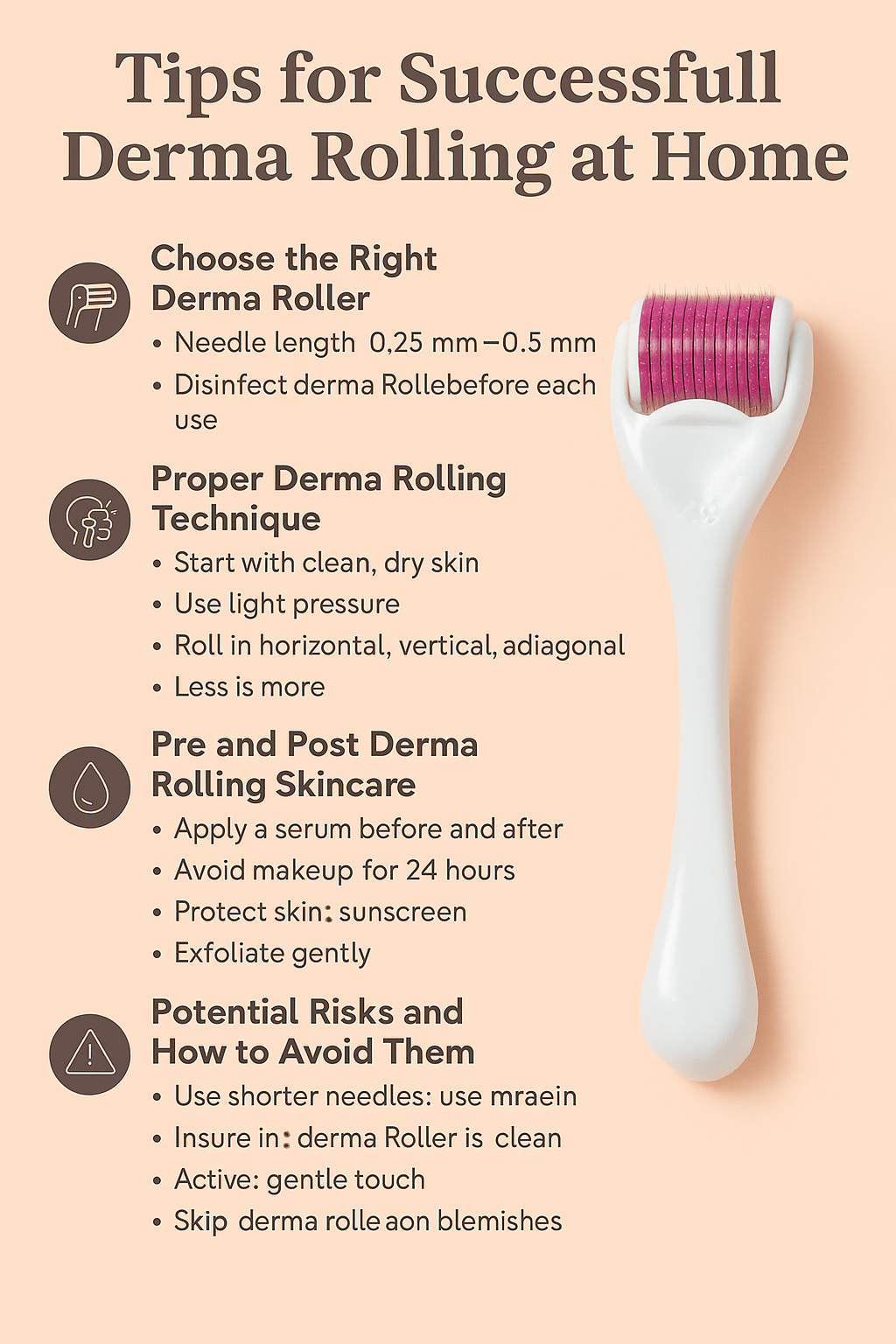
Tips for Successful Derma Rolling at Home
Share
Tips for Successful Derma Rolling at Home
What Is Derma Rolling and Why Does It Work
Derma rolling—also known as microneedling—is one of the most effective at-home treatments for smoother, firmer, and more youthful-looking skin.
It works by using a small roller with tiny microneedles to gently puncture the skin. These micro-injuries trigger collagen and elastin production, helping to:
- Smooth fine lines and wrinkles
- Fade acne scars and pigmentation
- Improve product absorption
- Boost overall skin texture and tone
While professional microneedling sessions can be expensive, derma rolling at home—when done correctly—offers an affordable and safe alternative.
Below, we’ll cover how to do it step-by-step, what to use before and after, and how to avoid common mistakes.
Step 1: Choosing the Right Derma Roller

The first step toward safe and effective derma rolling is choosing a roller suited to your skin’s needs.
Needle Length Guidelines:

| Skin Concern | Recommended Needle Length | Frequency |
|---|---|---|
| Product absorption & hydration | 0.25 mm | Every other day |
| Fine lines & uneven texture | 0.5 mm | Once a week |
| Deep scars & wrinkles | 1.0 mm+ | Professional use only |
Start small. For home use, 0.25–0.5 mm needles are ideal. They are safe, effective, and minimise irritation risk.
Needle Material Matters:
- Titanium needles — durable, high-quality, less prone to dulling.
- Stainless steel needles — more affordable but require frequent replacement.
Pro Tip:
Always purchase your derma roller from a trusted skincare brand or medical supplier. Cheap or poorly made rollers can bend, rust, or damage your skin.
Step 2: Sanitise Everything — Every Time
Hygiene is critical for preventing infection. Follow these simple steps before and after every session:
Before Rolling:
Cleanse your face with a gentle, fragrance-free cleanser.
- Disinfect your roller in 70% isopropyl alcohol for 5–10 minutes.
- Pat your face dry with a clean towel.
After Rolling:
Wash the roller under warm water and mild soap.
- Re-soak it in alcohol for 10 minutes to sanitise.
- Store it in a clean, dry case.
Never share your roller with anyone and replace it after 10–15 uses (or sooner if the needles feel dull).
Step 3: Master the Proper Derma Rolling Technique

Technique determines your results — and your comfort.
Here’s how to roll like a pro:
Divide your face into zones (forehead, cheeks, chin, neck).
Roll in horizontal, vertical, and diagonal directions 3–4 times per section.
- Use light, even pressure—don’t drag or press too hard.
- Lift the roller after each stroke to avoid scratches (“tram lines”).
- Never roll over active acne, cuts, or irritated areas.
Tip: Less is more. Gentle, consistent sessions yield better collagen production than aggressive rolling.
Step 4: Apply Hollyberry Hyaluronic Acid Serum Immediately After

Right after derma rolling, your skin is most receptive to hydration and nutrients. This is the perfect time to apply Hollyberry Cosmetics’ Hyaluronic Acid Serum.
Why It’s Essential Post-Microneedling:
- Instant hydration: Binds 1,000x its weight in water to deeply hydrate.
- Soothes redness: Cools and calms freshly rolled skin.
- Boosts collagen: Supports new cell growth and elasticity.
- Improves absorption: Microchannels allow deeper serum penetration.
To apply:
- Dispense 2–3 drops of Hollyberry Hyaluronic Acid Serum into your palms.
- Gently pat onto clean, rolled skin—don’t rub.
- Follow with a lightweight, barrier-repair moisturiser.
Pro Tip: Continue using the serum daily between rolling sessions for ongoing hydration and plumpness.
Order Hollyberry Hyaluronic Acid Serum Here
Step 5: Post-Rolling Skincare & Aftercare Tips

After derma rolling, your skin needs extra care and protection.
Do:
- Use broad-spectrum SPF 30+ daily.
- Keep skin clean and hydrated.
- Use gentle cleansers and moisturisers.
- Apply Hyaluronic Acid Serum twice daily for 3 days post-roll.
Don’t:
- Apply makeup for 24–48 hours.
- Use retinol, AHAs, or BHAs immediately after rolling.
- Touch your face with unwashed hands.
- Expose skin to direct sunlight or hot showers for 24 hours.
Following these tips ensures faster healing, better absorption, and visible results within weeks.
Step 6: Understand the Risks (and How to Avoid Them)

Derma rolling is safe when done properly, but mistakes can cause irritation.
Common Issues & Fixes:
| Problem | Likely Cause | How to Fix |
|---|---|---|
| Redness or swelling | Rolling too hard or too often | Use gentler pressure; apply a cooling gel or Hollyberry Hyaluronic Acid Serum |
| Breakouts or infection | Unsanitized roller | Disinfect thoroughly before & after every session |
| Pain or bleeding | Needle too long | Stick to 0.25–0.5 mm for home use |
| Dryness or peeling | Skipping hydration | Apply Hyaluronic Acid Serum daily |
| Worsened acne | Rolling over active pimples | Avoid affected areas |
If irritation persists, stop rolling for one week and consult a dermatologist.
Step 7: Track Progress and Stay Consistent
Derma rolling results build gradually. To see progress:
- Take before-and-after photos every 4 weeks in the same lighting.
- Keep a rolling log with dates and needle sizes.
- Stick to a regular routine—consistency is key to lasting results.
After 8–12 weeks, you’ll notice a smoother texture, smaller pores, and a radiant glow.
Final Thoughts: Your At-Home Glow Routine
When performed with care, derma rolling at home is a powerful way to rejuvenate your skin.
The winning combination?
A quality derma roller + Hollyberry Cosmetics Hyaluronic Acid Serum.
Together, they hydrate, renew, and enhance your skin’s natural radiance—without the cost of professional treatments.
Experience visibly smoother, firmer, more luminous skin—right from home.
Shop Hollyberry Hyaluronic Acid Serum to elevate your derma rolling results today.
